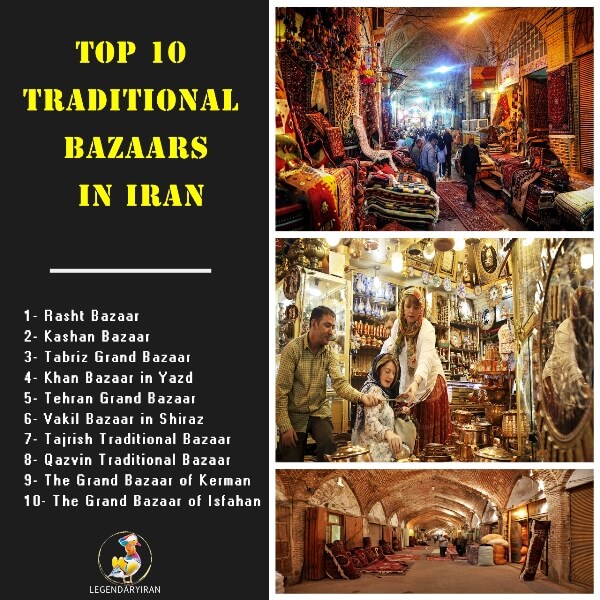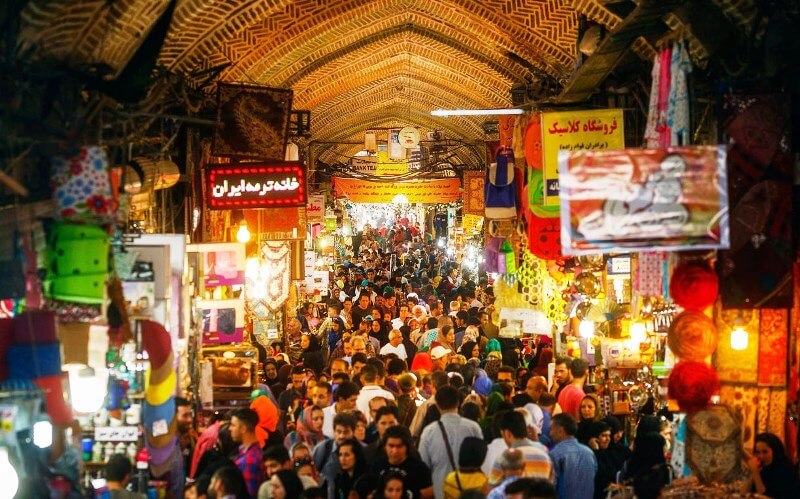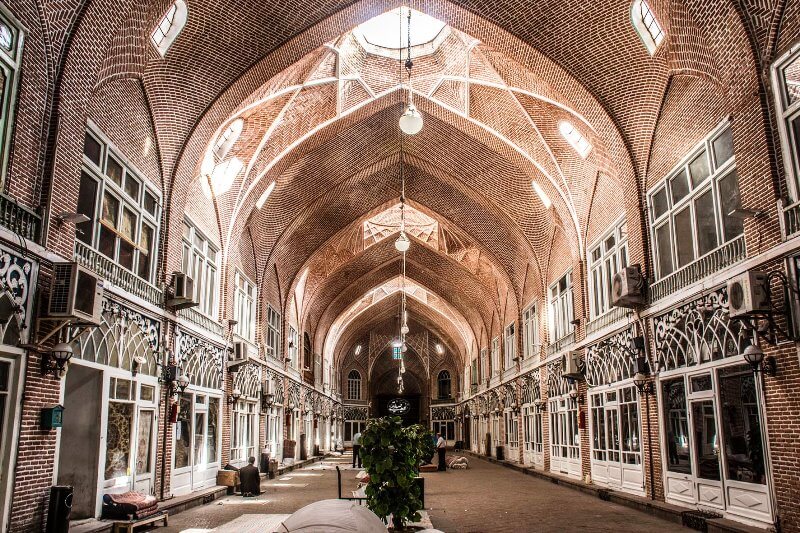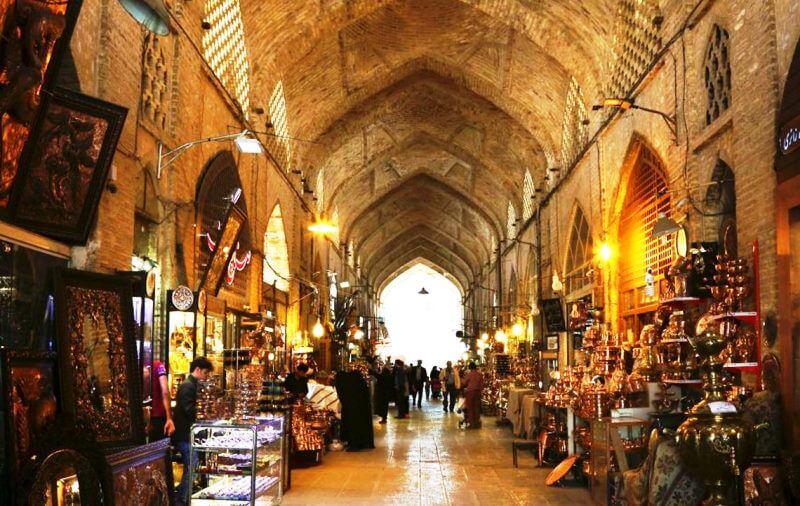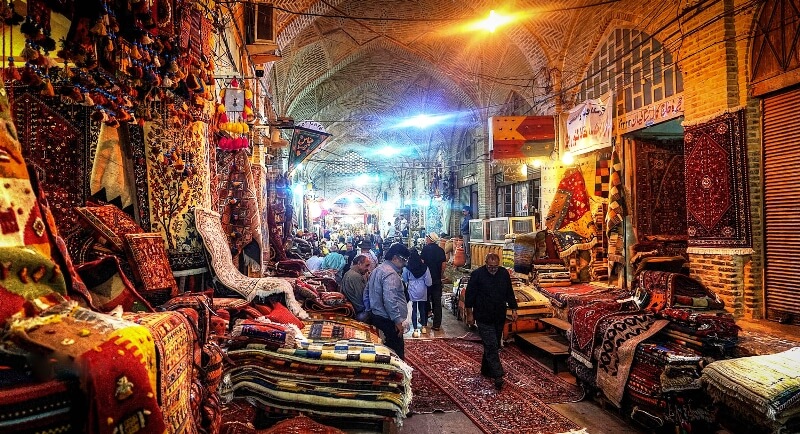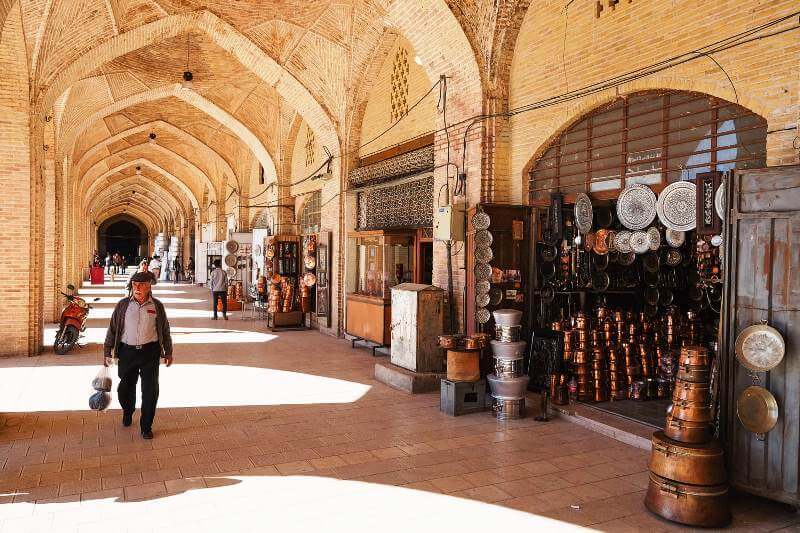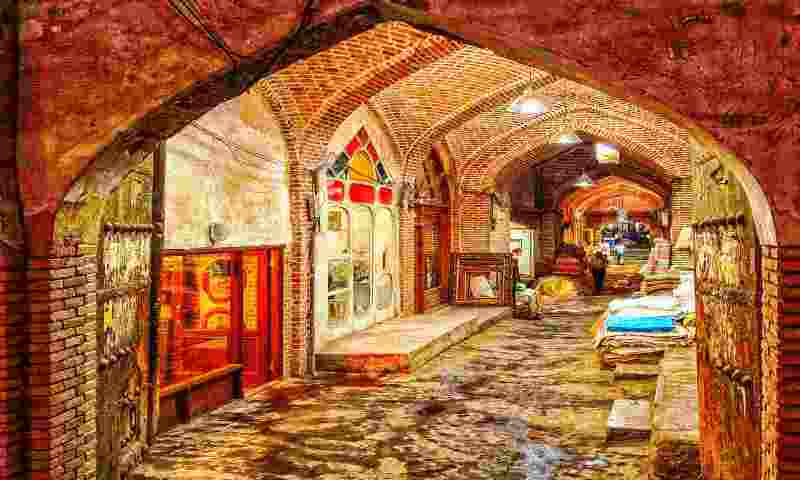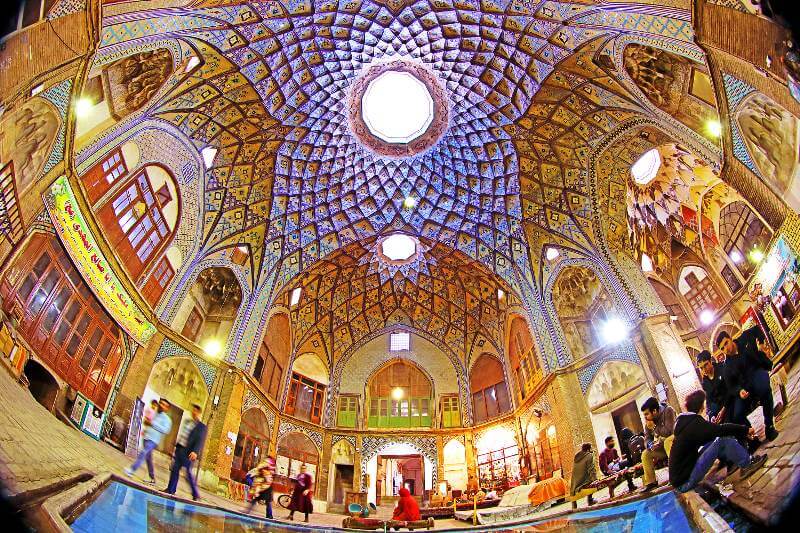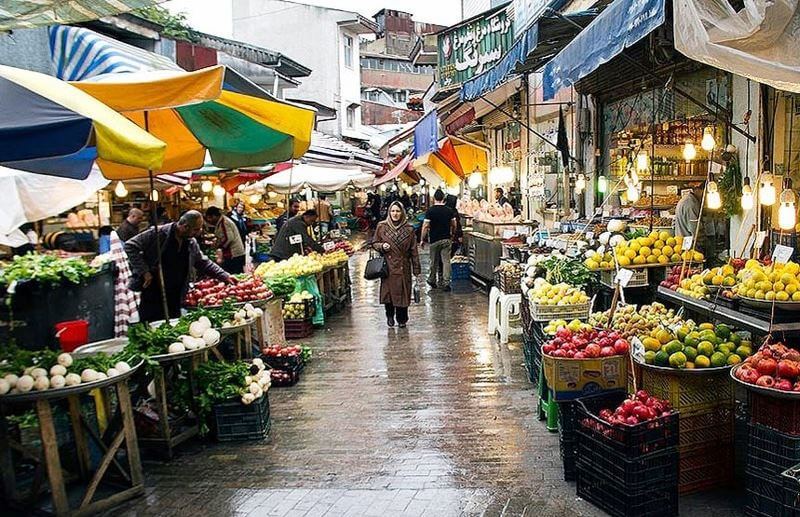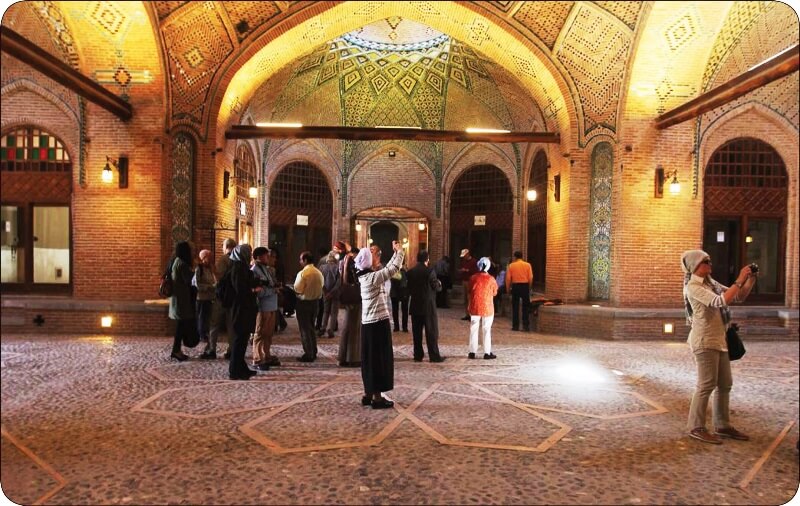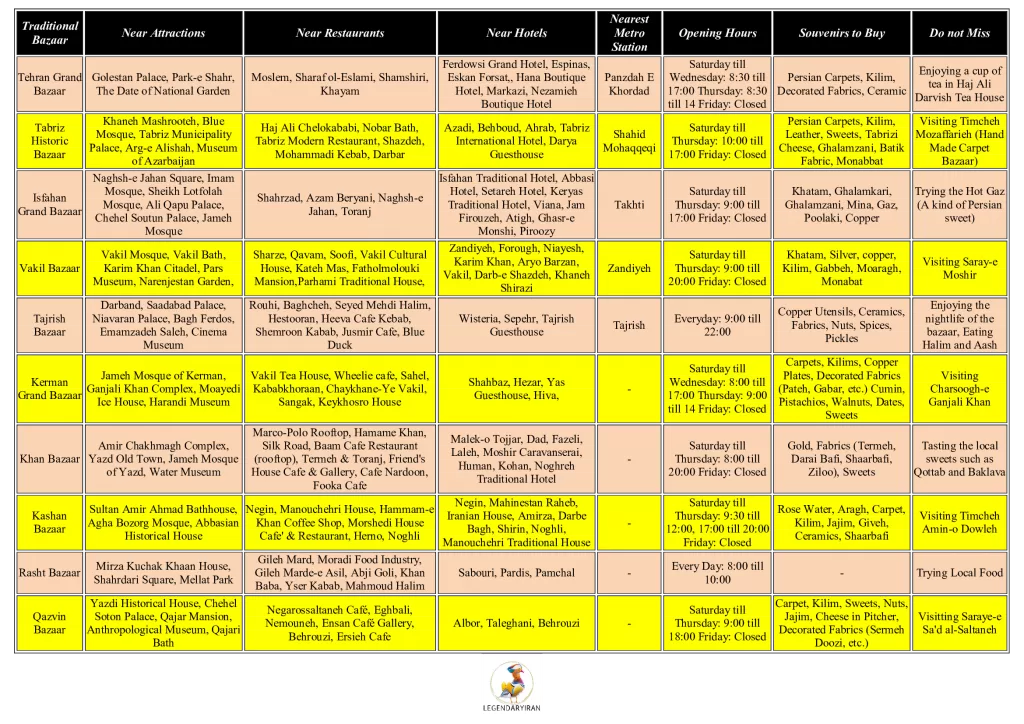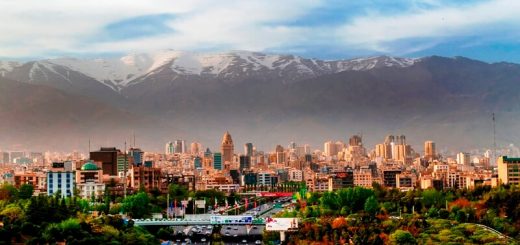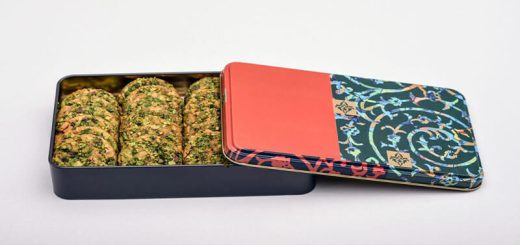Top 10 Traditional Bazaars in Iran for Tourists
by Admin · September 5, 2021
Best Persian Bazaars in Iran
Welcome to the Persian Bazaar, a typical alluring scenario full of tradition and history that can be found in every corner of Iran. The traditional bazaars in Iran are key points in the life of the locals, where meetings go far beyond the purchases. They are the authentic places where you can experience pure Iranian kindness, rich culture, history, marvelous architecture, and maybe become enthusiastic about buying colorful Iran souvenirs; Who knows?
“Bazaar Meaning:
A bazaar or souk, is a permanently enclosed marketplace or street where goods and services are exchanged or sold. The term bazaar originates from the Persian word bāzār"
Stay with us to get essential information about the top 10 traditional bazaars in Iran. Also, in the table at the end of this blog, you can get helpful details about visiting these Persian bazaars, including their locations, nearby hotels, restaurants, attractions, metro stations, best souvenirs to buy, etc.
Moreover, if you have any questions about visiting Iran traditional bazaars, do not hesitate to contact us.
Tehran Grand Bazaar
Tehran, the capital of Iran, houses one of the largest and most important bazaars in Asia, known as the Tehran Grand Bazaar. This bazaar, dating back to the Safavid era, is one of the oldest and greatest (about 105 hectares) traditional bazaars in Iran.
Tehran Grand Bazaar, consisting of numerous stalls, warehouses, shops, and Iranian and foreign companies agencies, is Iran’s most important commercial center. Notably, its architectural structure is a combination of the Safavid and Qajar periods.
Now, the market combines traditional and modern aspects and offers various goods, including food, clothing, jewelry, Persian carpets, and handicrafts, at reasonable prices.
Moreover, traditional cafes, an integral part of Iranian culture, have special importance in the Tehran bazaar. These coffee houses serve traditional Persian foods in addition to cold and hot beverages.
There are also many traditional restaurants in the Tehran Grans Bazaar, such as Sharaf ol Eslam, Moslem, and Shamshiri restaurants.
On the other hand, other spectacular parts of the Tehran Grand Bazaar include mosques, zurkhanehs, and bathhouses rich in Iranian architecture.
Moreover, in the middle of the bazaar, there is a paving and a small water stream; on the sides, old trees have created a wonderful view. Besides, domes, and skylights, along with traditional plaster ornaments and tilework, dazzle the eyes of every viewer.
Among the spectacular parts of Tehran Bazaar, we can mention the gate in Sabzeh Maidan, Timcheh Hajeb ol Doleh, and the tomb of Imamzadeh Zaid with outstanding mirror work.
Finally, Tehran Grand Bazaar is located on Molavi Street, which is very easy to access by public transport such as subway and bus.
Tabriz Grand Bazaar
Tabriz Grand Bazaar, which is among the must-see Tabriz attractions, is one of the oldest traditional bazaars in Iran; A large and covered bazaar that has created a mysterious atmosphere by applying the magnificent features of ancient Iranian architecture.
Notably, Tabriz Bazaar is the largest indoor market in the world. You will understand the meaning of “the largest indoor bazaar” when you stand under the domed roof of a bazaar that is one kilometer long. Even French Chardin considered it the best market in Asia, with beautiful domes and spectacular arches. He also described the wide octagonal stall of Caesarea as the most beautiful part of the market. On the other hand, Ibn Battuta, the famous traveler, expressed: “Tabriz Bazaar was one of the best bazaars I have ever seen in all cities of the world.”
The current building of Tabriz Bazaar dates back to the early Qajar period and has been registered in the UNESCO World Heritage List.
It is noteworthy that this grand bazaar owes its glory to the caravans that once came to cross the Silk Road.
Iranian architectural style, 6500 shops, stalls, corridors, schools, caravansaries, and a mosque are among the prominent features of this market. The most famous order of Tabriz Bazaar is the order of gold sellers.
The Grand Bazaar of Isfahan
Many tourists know Isfahan with Naghsh-e Jahan Square and its big and historical bazaar; The oldest and largest market in Isfahan.
Isfahan Grand Bazaar, with unique architecture, is one of the oldest and most beautiful middle-eastern bazaars. With stalls and shops selling the same old goods for 400 years, this bazaar is located in the Naghsh-e Jahan Square, the UNESCO site that dates back to the Safavid period. Researchers believe that the structure of Isfahan city is based on the principles of this market, so it is one of the most important traditional bazaars in Iran.
The Isfahan Grand Bazaar ends in the Jameh Mosque and the Arab Bazaar, and some parts are also located in Atiq Square. Hence, there are several entrances to this bazaar that the most famous one is the Qeisarieh entrance in the north of Naghsh-e Jahan Square. This 400-year-old wooden entrance decorated with tiles, mosaics, muqarnas, and paintings of Shah Abbas dazzles the eyes of any viewer. Behind this entrance lies Qeisarieh Bazaar, which houses several mosques, baths, a large school, numerous stalls, etc.
Besides, the important sections of this market include the Khansariha, Golshan, Fakhr, Zargarha (gold sellers), Mesgarha (blacksmiths), shoemakers, confectioners, etc. The sound of hammers on the metal in the blacksmiths’ corridor is one of the most interesting attractions of Isfahan Grand Bazaar.
Notably, if you are a fan of handicrafts, you can find colorful handmade crafts in this market. Also, you can see the creation of these handicrafts by skilled artisans.
Vakil Bazaar in Shiraz
Vakil Bazaar is a traditional Persian bazaar built in the 11th Century by Karim Khan Zand in Shiraz. This bazaar is a beautiful building that reflects the typical architecture of the Persian Bazaar with a vibrant and bustling atmosphere. Also, Vakil Bazaar is still a vibrant trade hub for selling spices, rugs, handmade copper utensils, Khatam, silver, antiques, Persian sweets, etc. Interestingly, with an area of 21840 square meters, Vakil Bazaar is one of the largest traditional roofed bazaars in Iran.
Furthermore, it is the most beautiful traditional bazaar in Iran with its domes brick ceiling; along with being beautiful, it keeps the building cool during summer and warm during winters. So It is one of the best places to visit in Shiraz in the summertime.
Moreover, Along with shopping for traditional souvenirs, meeting locals, and enjoying its artistic architecture, you can rest in cozy cafes and restaurants in the area of this bazaar. Notably, two of the most famous parts of Vakil Bazaar are Saraye Moshir and Saraye Fil, including courtyards, cafes, and souvenir shops.
Finally, as the Vakil bazaar is a monument of the Zandiyeh complex, you can visit other parts of this complex, including Vakil Bath and Vakil mosque near the bazaar. Therefore it is one of the must-visit attractions in Shiraz.
Tajrish Traditional Bazaar
Tajrish Bazaar is one of the attractions in Tehran, which offers a variety of goods and Persian handicrafts. This bazaar is located in the heart of Tajrish historical neighborhood and near Imamzadeh Saleh (AS). Tajrish Bazaar is estimated to be 70 years old; however, its old merchants say it is over 150 years old. On the other hand, structures such as the famous 220-year-old Tajrish Grand Tekiyeh show the Tajrish Bazaar’s antiquity.
Tajrish Bazaar is not only a place for trades but also a cultural and social center; A combination of bazaars, mosques, shrines, prayer rooms, and restaurants in one neighborhood. Actually, Tajrish Bazaar is a smaller example of the Tehran Grand Bazaar. In addition, there is an indoor fruit and vegetable market in this bazaar, which is very popular among domestic and foreign tourists.
In the Tajrish market, all kinds of goods, including fresh foods, nuts, Iranian saffron, spices, pickles, handicrafts including kilim, inlay, enamel, copper, pottery, etc., are sold.
On the other hand, several malls such as Ghaem and Tandis shopping centers lie near Tajrish Bazaar, where you can continue your sightseeing and shopping.
Finally, Tajrish Bazaar is open all days of the week, even on Fridays (unlike other traditional bazaars in Iran), from 9 am to 10 pm.
The Grand Bazaar of Kerman
Kerman Grand Bazaar consists of several buildings and bazaars built during the Timurid and Gurkanian periods and expanded during the Safavid and Qajar eras. Therefore, it is known as one of the oldest traditional bazaars in Iran. Notably, the most important parts of the Kerman Bazaar include the Vakil Bazaar, Ekhtiari Bazaar, Ganjali Khan Bazaar, Ghaleh Bazaar, and Sardar Bazaar, each of which is a relic of a specific period of Iranian history.
The Grand Bazaar of Kerman lies between the Arq and Moshtaqiyeh squares. When you enter the market from Arg Square, a magnificent building with delicate decorations and tile works appears in front of your eyes.
Also, the green spaces surrounded by buildings create a special atmosphere that you can not experience in either middle eastern bazaars. You can see vestibule arches connected to pillars, and above them are small and large domes. Besides, Charsooq (the intersection of the bazaar corridors) of Kerman Bazaar is circular and is surrounded by vestibule arches. Also, Charsouq’s plasterworks and oil paintings create a more spiritual atmosphere. Moreover, entrances decorated with turquoise tiles, windcatchers, caravanserais, etc., are other features of Kerman Bazaar.
Notably, Ganjali Khan Bazaar is one of the largest and most beautiful old bazaars in Iran, where you can find other sections such as mosques, caravanserais, houses, and baths.
Furthermore, Chehelston Mosque, Golshan Caravanserai, Sardari Hammam Bazaar, and Vakil Coffee are located in the Ekhtiari bazaar, one of the oldest sections of Kerman Bazaar.
On the other hand, Aziz Bazaar, Mozaffari Bazaar, Ebrahim Khan Bazaar, Copper Bazaar, Mahmoud Castle are other important parts of Kerman Bazaar.
Finally, you can visit a caravanserai and a temple of Hindus who were bringing spices and medicine to Iran in ancient times.
Khan Bazaar in Yazd
The historical bazaars of Yazd with beautiful minarets and windcatchers reflect the ancient Iranian-Islamic architecture. These Persian bazaars have played an essential strategic role in the historical context of Yazd and are the best places to buy traditional handicrafts.
In this regard, one of the most beautiful, largest, and most famous of these ancient Persian bazaars in Yazd is Khan Bazaar, dating back to the Qajar Period.
Notably, the complex of Bazaar, Hosseinieh (a place like a mosque), Ab Anbar(water reservoir), and the bath next to it represent the ancient architecture of the desert. All of these monuments are located in the Historic City of Yazd, which is an Iran UNESCO Site.
Moreover, the Khan Bazaar consists of several corridors and small bazaars, including Zargari, Panjeh Ali, Qeisarieh, Alaqbandi, Chit Sazi, Mulla Ismail, Afshar, Sadri, etc.
Finally, you can buy all kinds of Yazd souvenirs, including Termeh, traditional sweets, Ziloo and pottery, and copper utensils from this traditional market.
Kashan Bazaar
Kashan traditional bazaar, dating back to the Safavid era, is one of the old and beautiful traditional bazaars in Iran, renovated and expanded during the Qajar period.
The Iranian architecture of this market is fantastic, particularly in Timcheh Amin o Dowleh section, where a turquoise pool is located under a high dome and surrounded by beautiful arches. Light comes from the wooden windows into the bazaar and reflects on the pond. Geometric lines are wonderfully placed next to each other, and the walls and the dome ceiling are decorated with colorful tiles and gypsum Muqarnas. Also, old paving covers the floor.
In The Kashan Bazaar, most sections are built on two or three floors with porches overlooking the corridors. Also, you can see one of the strangest and most complicated Oriental architectures in the traditional market of Kashan.
Other parts of Kashan Bazaar are baths, mosques, and different corridors, each dedicated to a specific profession and product. Among the sections of Kashan Bazaar, Sarpareh Passage, Panjeh Shah Passage, Imamzadeh Habib Ibn Musa Passage, Pay Qapan Passage, Darvazeh Isfahan Passage, Mir Panj and Gomrok Caravanserais, etc. are more famous. In this market, you can feel the delighting scent of rosewater everywhere.
Rasht Bazaar
Rasht Bazaar, also known as Rasht Grand Bazaar or Rasht Traditional Bazaar, is a traditional Persian Bazaar that is the most bustling spot in Rasht.
Notably, Rasht is a vibrant city in the Gilan Province in the North of Iran. You can also find many traditional bazaars in other towns of Gilan Province, including Astara, Fuman, Talesh, Bandar Anzali, Roodbar, Masouleh, and Somiehsara. There are also many daily bazaars in this region where the rural folk presents their goods for sale.
By the way, among all local bazaars in the north of Iran, Rasht Grand Bazaar, dating back to the Safavid era (1501 – 1736), is the most famous one with an area of about 24 hectares. However, unlike other traditional bazaars in Iran or even middle eastern bazaars, it is not covered with ceiling domes.
Besides, Rasht Bazaar houses 14 caravanserais dating back to the Qajar and Pahlavi dynasties.
Finally, this bazaar has maintained its traditional appearance and is a vibrant market where local foods, fish, vegetables, fruits, and traditional handicrafts are sold.
Souvenirs you can buy in Rasht Bazaar: Local Handicrafts, Local Sweets
Qazvin Traditional Bazaar
Qazvin is an ancient city located about 150 km northwest of Tehran. Interestingly, Qazvin Traditional Bazaar is one of the oldest traditional bazaars in Iran. This market dates back to about a thousand years ago, but the current building belongs to the Safavid and Qajar periods.
After selecting Qazvin as the capital of Iran during the Safavid period, a large square was built in the center of the city, which became the main platform of the Qazvin Bazaar. Later, this square became a model for the construction of Naghsh Jahan Square. Of course, the square no longer exits, but Qazvin Bazaar still stands with its beautiful Iranian-Islamic architecture.
Interestingly, the most beautiful part of Qazvin Bazaar is Saad Al-Saltaneh Palace, with its fantastic tile works. On the other hand, Qaisaria Bazaar, with its high arched roofs, is another beautiful section of Qazvin Bazaar.
Like this article?
Subscribe To Our Newsletter
Get updated articles about Iran trip

